The 7 Best AR-15 Bayonets of 2025: All Budgets
Over the years, we’ve seen a lot of cool and crazy AR-15 accessories. The versatility of the AR-15 is one of the things we most love about it. Of all the accessories we’ve tried and tested, one of the most overlooked add-ons are AR-15 bayonets.
Bayonets? We know what comes to mind.

But a good bayonet can serve a number of purposes, such as being an effective weapon in close-quarters combat, a handy tool in utility tasks such as cutting wire, or as an essential bushcraft survival tool. For people looking to buy their first AR-15 bayonet, we recommend the Ontario Knife Company 6143 M9 Bayonet. Of all the bayonets we’ve tested, we think the 6143 M9 is the most complete and reliable offer on the market.
If you’re looking for a more budget friendly option, something more old school, or a better value pick, we have other recommendations, too.
1. BEST AR-15 BAYONET: OKC 6143 M9

Ontario Knife Co. 6143 M9 Bayonet & Scabbard
When it comes to do-it-all capability, the original Ontario M9 Bayonet stands at the top. This is the real McCoy – the current U.S. Army-issue bayonet – and it was literally designed to be a multipurpose survival tool as much as a weapon.
Ontario’s model 6143 M9 is built to military specifications for mounting on M16/M4/AR-15 rifles, and it shows in every aspect of its construction.

Why We Like It: The Ontario M9 has nearly four decades of service under its belt, and it’s still issued for a reason. It serves as a utility knife and a wire cutter with its scabbard, in addition to functioning as a bayonet.
The 7-inch blade is a beefy 0.24 inches thick and forged from 420-modified stainless steel hardened to about 53-57 HRC, giving a tough, corrosion-resistant edge that can handle battlefield abuse. It features the classic M9 clip-point shape with a sharpened false edge, combined with a serrated spine that turns it into a makeshift saw for wood or bone.
Pair it with the included scabbard, and you unlock even more utility: the sheath’s built-in cutter turns the knife into a wire-cutting tool for fencing or barbed wire.
Everything about the OKC 6143 is rugged. The blade’s 420 stainless may not sound exotic, but Ontario’s heat treatment and phosphate coating over the blade ensure it won’t chip or corrode easily, even when digging or prying. It’s a full tang blade (though like all M9s, the tang is bolted inside the handle rather than one continuous piece to the pommel) and feels very strong.
Weight with the sheath is about 1.5–1.8 lbs, giving it a reassuring heft for chopping or thrusting.
Flaws but Not Dealbreakers: As the saying goes, the M9 is the jack of all trades, master of none. By combining so many functions, it inevitably compromises pure performance in some areas.
For example, the blade is relatively thick and heavy, so finer slicing tasks (like cleaning small game or whittling) are clumsier compared to a dedicated field knife. And while the 420-series steel is tough and rust-resistant, its edge retention is moderate – the blade loses its edge faster than high-carbon knives, meaning you’ll want that sharpening stone handy for extended use.
The sheath setup is a little bulky. The issued scabbard is strong, but not very sleek. A lot of users swap it out for a simpler aftermarket one when using the knife on its own.
Also, the bayonet’s latch mechanism can rattle slightly when not mounted on a rifle, though a bit of tape or a sheath with retention straps easily mitigates this.
Bottom Line: Ontario’s OKC M9 bayonet is the quintessential “do-everything” bayonet, earning its place as the most versatile option. It’s as comfortable on the end of your rifle as it is on your belt, ready to tackle tasks from breaching to bushcraft in a single package. No, it’s not a surgical slicer or a lightweight backpacking knife, but if you need a blade that can fill virtually any role in a pinch, the M9 is the one you grab.
2. BEST FIGHTING BAYONET: OKC 6504 OKC-3S Bayonet

Ontario Knife Co. 6504 OKC-3S Bayonet
The Ontario OKC-3S is the United States Marine Corps’ current issue bayonet, and it’s purpose-built to serve as both a bayonet and a frontline fighting knife. From the moment you pick it up, you can tell the OKC-3S means business. It sports an 8-inch high-carbon steel blade (1095 steel) with a clipped Bowie-style point – a nod to the Marines’ beloved Ka-Bar knife.
In fact, the OKC-3S looks like a Ka-Bar on steroids, re-engineered to mount on an M16/M4. The blade is phosphate-coated for corrosion resistance and serrated near the handle for 1.75 inches, giving extra cutting power on fibrous materials.

Why We Like It: Because it was designed with modern combat in mind, everything about the OKC-3S is overbuilt: it’s thicker and larger than the old M7 bayonet, yet slightly slimmer and lighter than the Army’s M9, improving its agility in hand.
The handle is a textured brown polymer that’s ergonomically shaped for a secure grip, even with wet or gloved hands. This bayonet also comes with a hardy polymer scabbard (in coyote brown to match USMC gear) that’s MOLLE-compatible for easy carry on a vest or pack.
As you’d expect from a knife made for Marines, the OKC-3S is built tough. The blade’s 1095 carbon steel is tempered to around 55-57 HRC, giving it excellent edge retention and strength for field use. More than likely, it will outlive you.
Unlike the standard M9, the OKC-3S’s blade is full tang (one solid piece) embedded in the handle, which adds durability for prying and striking. Everything down to the grip texture and guard is made to withstand harsh conditions (it’s spec’d to not break from -25°F to 135°F). I’d say this is a knife you can trust when the going gets ugly.
Flaws but not dealbreakers: The OKC-3S forgoes some of the utility features of the M9. Notably, there’s no wire-cutter attachment on the scabbard, and the blade’s spine has serrations for a few inches rather than a full saw. This means it’s less suited to certain field tasks like sawing wood or cutting fencing compared to an M9 bayonet.
The price tag comes in around $175-$200, a little more than the M9. That’ll get you upgraded steel and a better build quality. We consider it worth it if you specifically want the best combat-oriented bayonet, but casual users who just need a basic bayonet might find it more than necessary.
Bottom Line: The OKC-3S is the bayonet to beat when it comes to modern combat and fighting applications. It brings the legendary fighting-knife heritage of the Marines into a bayonet that’s tough, lethal, and practical for today’s battlefield. For those who want a bayonet that doubles as a formidable combat knife – one you’d actually carry by itself into a fight – the OKC-3S is the clear choice.
3. BEST BUDGET BAYONET: Wartech M9

Wartech M-9 Bayonet
This is a modern replica of the M9 bayonet that emphasizes style and accessibility at a hard-to-beat price. It has all the bones of an M9, including a 7.8-inch stainless steel blade (typically 3Cr13 steel) with a partial saw back and a functional bayonet lug mount.
The handle is molded ABS polymer, and many versions ship with a standard M9-style hard sheath featuring an integrated wire-cutter.

Why we like it: What sets Wartech’s bayonet apart is that it’s incredibly affordable, often around the $30 mark, making it an attractive choice for those who want the bayonet experience or appearance without a big investment.
Despite the low price, the Wartech M9 isn’t just a wall-hanger; it’s a working knife. The blade is thick (about 5mm) and full-size, so it can hack and stab effectively. The fact that it includes a wire-cutter sheath on many models means it retains the core function of an M9 bayonet system.
It may not be military-grade, but it will absolutely serve for basic tasks, training exercises, or emergency use. Consider it a great starter bayonet: you get the feel for how a bayonet handles without dinging up a $150 blade.
Flaws but not dealbreakers: The quality can be a bit hit-or-miss. Some knives arrive razor sharp with solid assembly, while others might have cosmetic issues or need a tune-up.
The good news is returns/exchanges have resolved most issues, and at this price point Wartech likely prioritizes getting units out over meticulous finishing. Our take: be prepared to do a little DIY (sharpening, slight sanding) to get it just right.
While functional, this bayonet is not built for life-and-death situations, and it’s important to state that plainly. The steel (3Cr13) is on the softer side, meaning the blade can dull relatively quickly and won’t hold up to extreme abuse like prying or hard impacts as well as a tempered 1095 blade would.
Also, little things like the retention of the scabbard or the tolerances of the locking mechanism might be looser. None of this is a problem if you use the Wartech for light-duty and display – it’s honestly perfect for that. Just avoid expecting a $30 knife to perform like a $300 one.
Bottom Line: The Wartech M9 bayonet is the best choice for someone who wants an aggressive-looking bayonet for show or casual use. Mounted on your rifle, it gives you that full tactical vibe, and in hand, it can work as a survival knife in a pinch.
4. BEST HIGH-END PICK: Extrema Ratio Fulcrum Bayonet

Extrema Ratio Fulcrum Bayonet
Extrema Ratio’s Fulcrum Bayonet is in a league of its own – a high-end, European-made bayonet that doubles as an elite tactical knife. This is the choice for those who demand the absolute best in materials and construction (and who don’t mind paying for it).
Made in Italy, the Fulcrum Bayonet features a 7-inch Böhler N690 cobalt stainless steel blade hardened to ~58 HRC. In layman’s terms, that means the blade has exceptional edge retention, toughness, and corrosion resistance; N690 is a steel often used in surgical instruments and upscale knives.

Why We Like It: The blade itself departs from the traditional spear-point shape: it’s a beefy tanto design with a swedge and partial serrations, built for maximum penetration and strength.
In fact, the Extrema Ratio is rated to withstand about 150 kg (330 lbs) of lateral force on the blade without breaking – you could practically use it as a pry bar in an emergency. It’s also designed to mount on standard AR-15/M16 lugs, so you get full bayonet capability.
The out of the box sharpness is superb, and edge rolling or chipping is nearly nonexistent even after heavy work. The handle’s Forprene material provides a grip that is firm yet has a bit of give, reducing shock when striking or chopping.
All components are securely fitted (no rattle at all). This bayonet is essentially a custom-grade combat knife that happens to fix onto a rifle. It’s the kind of knife where even small details, like the quality of the hex screws and the stitching on the sheath, are a cut above the rest.
Everything about the Fulcrum Bayonet exudes quality and over-engineering, from the DLC-coated blade finish to the meticulous fit of the bayonet lug mechanism. It’s easily the priciest bayonet on this list, but also the one that could survive the harshest abuse.
Flaws but not dealbreakers: The obvious drawback: the Fulcrum Bayonet is expensive. It often retails in the $300–$400 range, which is multiple times the cost of a basic bayonet. You are very much paying for the premium steel and Italian craftsmanship.
For most AR-15 owners, this is overkill (you could buy a decent AR optic or several budget bayonets for the same money). This bayonet is really aimed at serious collectors, professionals, or enthusiasts who demand top-of-the-line gear.
Minor point, but the unique tanto design and thickness mean this bayonet doesn’t quite fit some standard U.S. military accessories. For example, it won’t work with an M9 scabbard or older ALICE gear frog. Of course, it comes with its own excellent sheath, so this is only an issue if you were hoping to integrate it with existing bayonet frogs or have it blend in with surplus kit.
Additionally, its distinct appearance (very modern and different from a typical M7/M9) might not be everyone’s cup of tea if you prefer the GI look.
Bottom Line: The Extrema Ratio Fulcrum Bayonet is the ultimate premium choice for an AR-15 compatible bayonet. It’s the kind of tool you’d want at your side if you were dropped into the most unforgiving conditions – confident it will perform and survive. This bayonet isn’t for everyone, especially given its cost, but for those who can appreciate the difference, it absolutely earns its keep.
5. BEST UTILITY USES: Smith & Wesson SW3B M9
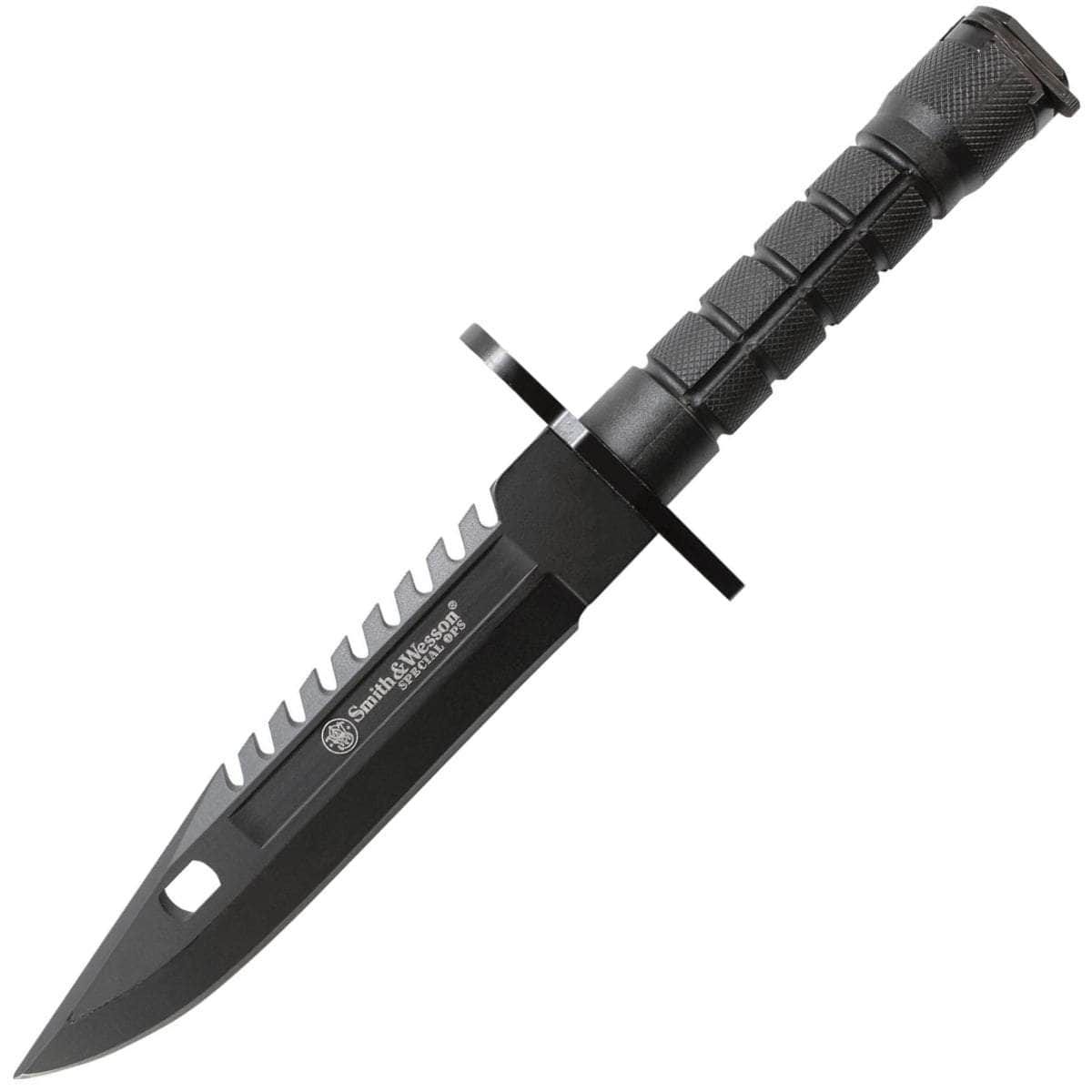
Smith & Wesson SW3B Special Ops M-9 Bayonet
Optics Planet (See Price)
Blade HQ (See Price)
Smith & Wesson’s SW3B Special Ops M9 bayonet offers the iconic military look and feature set of the U.S. issue M9, but in a civilian package. Don’t let the “Special Ops” name fool you, this isn’t an official service bayonet, but a well-made clone produced in Taiwan from 420J2 stainless steel.
It comes fully outfitted with the expected accoutrements: a black 7.8-inch spear-point blade with saw-teeth along the spine, a rubberized textured handle, and a multi-function scabbard that includes a wire-cutter attachment and even a sharpening stone in its pouch.

Why We Like It: The SW3B delivers all the hallmark features of the M9 design: generous blade length, a notched sawback spine, and a scabbard that doubles as a wire-cutter.
It also adds aggressive saw teeth reminiscent of the old Buckmaster survival knife, upping the cool factor.
The handle is made of a tough thermoplastic rubber over a nylon core, providing a no-slip grip even when wet. It fits the hand nicely, which is important when thrusting or using it as a field knife. The balance is tip-heavy (as expected for a bayonet), aiding momentum in drills.
For substantially less money than an authentic OKC M9, you get a dependable blade that is fine and well made, aside from a slightly less refined finish.
Flaws but not dealbreakers: It’s not truly Mil-Spec. Because this is a commercial clone, some aspects fall short of military-issue standards. The 420J2 stainless blade is corrosion-resistant but softer than high-carbon alternatives, meaning it won’t hold an edge as long as mil-spec bayonets.
There’s some minor fitting quirks. The bayonet lug attachment can be extremely tight on certain rifles until broken in. The tolerances aren’t as uniform as on an issued bayonet, so the first few mount/dismount cycles may be stiff. Also, the scabbard’s wire-cutter mechanism is very stiff out of the box, requiring effort to use. A quick lube or a bit of wear-in should improve it.
Bottom Line: The S&W SW3B M9 is the bayonet to grab for hands-on practice, tactical drills, or when you want the look and function of an M9 without the steep investment. It’s close enough to military-grade to feel authentic, yet inexpensive enough that you won’t hesitate to scuff it up.
6. BEST CLASSIC BAYONET: OKC M7-B Bayonet

OKC M7-B Bayonet
Sometimes you just can’t beat a classic. The Ontario M7-B Bayonet takes us back to the roots of the AR-15 platform, being a direct descendant of the original M7 bayonet issued in the 1960s. If you have a Vietnam-era rifle clone or simply appreciate the slim, no-frills style of old-school bayonets, the M7-B is the quintessential choice.
This bayonet features a 6.7-inch spear-point blade crafted from high-carbon steel (either 1080 or 1095) with a matte black phosphate finish for corrosion resistance. It’s thinner and shorter than the later M9, which makes it lighter on the end of your rifle and easier to handle in close quarters.

Why We Like It: The M7’s profile is lean and mean, designed primarily for thrusting in bayonet combat. There are no saw teeth, no complex attachments, just a sharpened blade with a secondary edge along the top third. The handle is a simple grooved polymer grip, and it attaches via a traditional pommel latch that locks onto any standard AR-15 bayonet lug.
Ontario Knife Company, one of the original contractors for M7 bayonets, still manufactures the M7-B to original spec, so you’re essentially getting military heritage in new production. For collectors and history buffs, that authenticity is a huge part of the appeal.
The M7-B is virtually identical to the bayonets G.I.s fixed on their M16s for decades. It entered service in 1964 and saw use from Vietnam all the way through the Cold War. Holding it, you feel that history. The blade shape and guard are straight out of military manuals, and Ontario’s version even comes with an M8A1-style scabbard, completing the retro look.
It has a slender 0.19″ blade thickness and shorter length. That translates into faster thrusting and slashing compared to the chunkier M9 type blades.
If you intend to do bayonet fencing or want a bayonet for home defense scenarios, the M7’s pointed, double-edged tip (the upper false edge is about 3 inches long) penetrates targets efficiently. Think of it as a long dagger on your rifle. It also works nicely as a fighting knife off the rifle; the blade has a good point and can take a decent edge for cutting.
Because it’s a current production of a classic, the M7-B is a top pick for collectors who want a mint condition example of this bayonet.
Flaws but not dealbreakers: The M7 is a product of its time, meaning it was designed mostly to stab enemies, not saw wood or cut wires. In the modern context, it’s less versatile than newer bayonets. There’s no serrated saw edge, no wire-cutter function on the sheath, and the blade’s upper half isn’t sharp (apart from the tip).
If you need a bayonet that doubles as a field survival knife, the M7 might disappoint. That said, it can perform basic utility tasks – it will slice, pry, or hammer in a pinch – it’s just not purpose-built for those roles.
With a 6.75″ blade and a fairly minimal hilt, the M7 gives up some reach and hand protection compared to bulkier modern designs. In bayonet fencing terms, an opponent with an M9 or OKC-3S will have an extra inch or two of blade to work with.
The handle, being a simple straight polymer grip, also lacks the textured comfort of newer models – it can feel slim and a bit slick if your hands are wet or bloody (gloves mitigate this).
Bottom Line: Ontario’s M7-B is a faithful revival of the classic M16 bayonet, making it the best choice for those who appreciate a traditional blade. While it doesn’t have the bells and whistles of newer bayonets, it excels in the role it was made for: a reliable bayonet with a deadly point and a storied history. If you’re outfitting a retro rifle or just love the nostalgia of U.S. military gear, the M7-B will put a grin on your face.
Read our full review here.
7. BEST SURPLUS REPLICA: Rothco GI-Style M9

Rothco Stainless Steel GI-Style M-9 Bayonet
Rothco’s G.I. Type M9 Bayonet is an homage to the classic U.S. military bayonet, delivering the style and features of the issue blade at a fraction of the cost. This model is an excellent copy of the Army’s M9, right down to the 7.8-inch stainless steel blade with dual blood grooves and a saw-tooth back.
At a glance you’d be hard-pressed to tell it apart from a genuine government contract bayonet. It mounts on a standard AR-15/M16 lug and even comes with a proper M9 plastic scabbard. The included sheath has all the bells and whistles: a quick-release belt clip, a built-in wire-cutter feature, and a sharpening stone in the front pouch.

Why We Like It: True to its name, this G.I.-style bayonet mirrors the dimensions and styling of the original. The 7¾-inch blade with a blood groove and saw back looks ready for the field.
Even the handle and latch mechanism are modeled after the mil-spec design, so it fixes to AR-15/M16 rifles securely.
This isn’t just a hollow replica though; it’s built to be used. The stainless steel blade is durable and rust-resistant, and the scabbard isn’t just for show either – it has the same multifunction capability as a service M9. That means you can hook the blade to the sheath and slice through barbed wire, saw small branches with the spine, and then sharpen it all up with the stone in the sheath’s pouch.
The bayonet is very sharp out of the box. The blade and handle hold up to general use (opening ammo crates, light chopping, etc.) without immediate issues. Essentially, you’re getting a full-sized combat knife/bayonet that you won’t think twice about actually using, since it’s not a pricey collectible. That’s a huge plus for anyone wanting a bayonet for rough-and-tumble duty or even for bayonet training drills.
Flaws but not dealbreakers: Rothco doesn’t advertise the exact grade of stainless steel used, and as expected, it’s not a high-carbon or premium steel. Edge retention is serviceable but not standout – after some hard use, you may notice it dulling faster than an official Ontario M9 would.
The upside is the included stone makes it easy to touch up in the field, and the blade’s thickness means it can take a bit of abuse even if the edge rolls sooner.
Being a mass-produced replica, the Rothco M9 may exhibit minor cosmetic or fitting quirks. The plastic grip and guards might have slight mold seams or play when compared to a tighter-tolerance military issue. The moving parts (bayonet lug latch, belt clip) can be stiff initially.
Bottom Line: For enthusiasts seeking an authentic USGI bayonet experience on a budget, Rothco’s G.I.-Type M9 delivers. It’s the best surplus-style replica out there, capturing the spirit and utility of the military original. While it’s not made of top-shelf steel or elite craftsmanship, it checks all the boxes for a functional, durable bayonet/knife that looks the part on any AR-15.
What are AR-15 Bayonets?
When we talk about bayonets, what comes to mind may be the muzzleloader types depicted in movies based on the Revolutionary War. It’s not far from the truth. Bayonets have been used in warfare for centuries, and they continue to have a place in modern tactical situations.
What exactly do we mean by “AR-15 bayonets?” Simply put, an AR-15 bayonet is a knife or blade that can be attached to the muzzle of an AR-15 rifle. It is not the primary use of the rifle, but it is a helpful add-on for many situations.

Why Use a Bayonet?
Bayonets may seem outdated and unnecessary in modern combat, but there are still a number of reasons why they can be useful. Primarily, a bayonet can serve as a backup weapon in close-quarters combat situations. That’s not exactly the first weapon of choice when going into battle, but accidents happen, such as a gun jamming or malfunctioning.
Better to have a backup, right?
In those situations, an operator must have the ability to fight, because let’s face it, what combatant is going to wait for you to fix your rifle?
“Just a minute, I swear this never happens.” Stage fright, amirite?
Bayonet Utilities
Bayonets do more than just serve as battle weapons. They have a number of utility tasks that can help operators perform in the field.
Cutting Wire or Rope
Bayonets can be highly effective for cutting wire, especially when used in conjunction with their sheath. Many models feature a small peg that the bayonet can attach to, creating a makeshift wire cutter.
Here is a prime example of this functionality in action.

Field Dressing
While you might typically have a hunting knife you like to use for this sort of thing, a bayonet can also get the job done. If you’re on a survival trip or bushcrafting in the wilderness, rather than going all Sméagol on that brace of coneys, you can use your bayonet to slice up your meal and prepare it.

Splitting Timber/Bushcraft
Bayonets are excellent tools for wilderness survival, perfect for tasks like splitting timber. When you’re out in the wilderness, you might need to start a fire for warmth or to cook food.
You can use the bayonet to chop wood and shave off small pieces to use as kindling. Collect these shavings into a pile, and then strike the bayonet with a piece of flint to ignite the fire.
Bushcraft requires a robust and durable knife capable of powering through a substantial section of wood. We’d recommend going with the OKC 6143 M9 for this sort of thing.
Warning Combatants
Finally, it’s worth noting that a bayonet can also serve as a powerful psychological deterrent in combat situations.
“There is nothing that a Marine wants to hear more than ‘fix bayonets’ and nothing that the enemy fears more,” said Sgt. Jonathan Shue, III Marine Expeditionary Force.
The mere presence of a bayonet fixed to a rifle can instill fear and uncertainty in opponents, potentially influencing their decision-making and actions on the battlefield. The sight of a bayonet signals a readiness for close-quarters combat, often perceived as a more personal and intense form of confrontation.
This psychological impact can be a crucial factor in the dynamics of engagement, sometimes even leading to the resolution of conflicts without the need for physical combat. The bayonet’s role as a symbol of resolve and aggression underscores its significance not just as a tool, but as a strategic element in warfare.
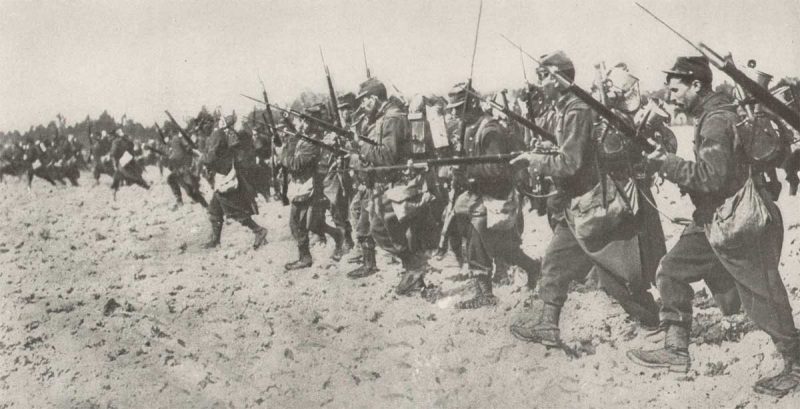
How to Choose the Right AR-15 Bayonet
There are a lot of options on the market, it can be tough to know which AR-15 bayonet to choose. Here are the main factors to consider when making your decision:
Blade Length
How long do you want your blade to be?

Size matters, or so some say. AR-15 bayonets come in a variety of lengths, typically between 6-12″. This is one of the first things to consider when choosing an AR-15 bayonet. Longer blades are better suited for combat situations, while shorter blades are better for utility tasks such as cutting a wire fence.
Blade Material
The choice of blade steel is crucial, and it’s essential to research the particular steel’s strengths and weaknesses. We wrote an in-depth guide to carbon vs stainless steel if you want to read more on it.
Always research the type of steel a bayonet has before making a purchase.
Here are some widely recognized, reliable steel types:
- AUS-8
- 420HC
- 154CM
- S30V
- 1095
- 440C
Stainless vs. Carbon:
Both stainless steel and carbon steel have their advantages. Let’s explore each type briefly.
Stainless Steel:
Stainless steel knives excel in overall strength and corrosion resistance. They’re unlikely to rust, chip, or bend easily. Additionally, stainless steel knives often have a more polished appearance.
On the downside, although they’re easier to sharpen, stainless steel blades typically don’t retain their sharpness as long as high carbon steel.
High Carbon Steel:
High carbon steel blades can achieve an incredibly sharp edge, almost surgical in precision. While they may be somewhat more challenging to sharpen, they maintain a sharp edge through extended and demanding use, making them ideal for accurate cutting.
The main drawback of high carbon steel is its susceptibility to rust faster than stainless steel.
Handle Material
Knife handles come in a wide variety of materials and designs. While there isn’t a specific checklist to follow when selecting a handle type or material for a survival knife, some guidelines can help you make the right choice.
It’s essential to find a handle that offers a full, comfortable grip, filling your hand entirely. This feature will contribute to your ease of use and minimize fatigue during extended periods of work.
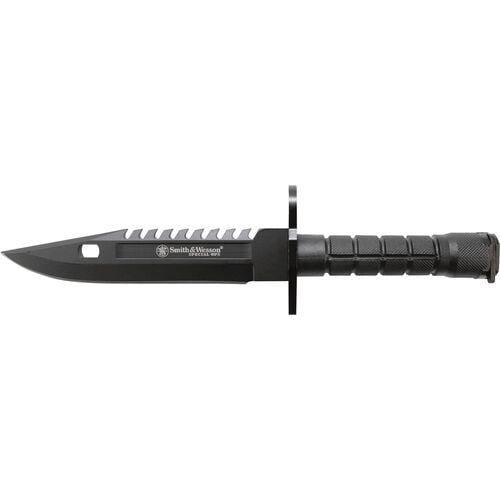
As for materials, there are numerous options, including leather, G10, various polymers, and rubbers. It’s generally advised to look for a textured handle to prevent the knife from slipping during use.
A good handle should also allow you to maintain a secure grip when your hands are wet, sweaty, or even while wearing gloves. Avoid overly aggressive textures that may cause hot spots or discomfort during extended use.
Sheath
Finally, consider the type of sheath that comes with the bayonet. Traditional sheaths, such as the M10, are not designed for modern gear. In fact, there are few options on the market that offer MOLLE webbing. We recommend you consider what gear you have and how you will attach the sheath to it

On the flip side, some sheaths, such as the M9, come with a sheath that features a flathead screwdriver and wire cutter, and includes a sharpening stone. Picking the right sheath just comes down to personal preference.
More for AR-15 Owners
15 Best AR-15s [2025]: Top Rifles for Every Budget and Skill Level
We independently test and review everything we recommend. When you buy through our links, we may earn a commission, which helps support our testing. Learn more. Looking for your first…
7 Best AR-15 Charging Handles [2025]: Hands-On Tested
We independently test and review everything we recommend. When you buy through our links, we may earn a commission, which helps support our testing. Learn more. Want to make that…
How to Clean an AR-15 (Step-by-Step Breakdown for Beginners)
We independently test and review everything we recommend. When you buy through our links, we may earn a commission, which helps support our testing. Learn more. “Cleanliness is next to…
11 Best AR-15 Suppressors 2025 (5.56 and Multi-Cal)
We independently test and review everything we recommend. When you buy through our links, we may earn a commission, which helps support our testing. Learn more. Ready to throw your…
Vortex Strike Eagle 1-8×24 LPVO Review [Real Lens Views]
We independently test and review everything we recommend. When you buy through our links, we may earn a commission, which helps support our testing. Learn more. If you’re in the…
15 Best AR-15 Rifles in 2025: The Ultimate List
We independently test and review everything we recommend. When you buy through our links, we may earn a commission, which helps support our testing. Learn more. “Guns, guns, guns.” Cue…
Final Thoughts
There’s something badass about affixing an AR-15 bayonet to the end of your rifle. It looks cool, but it also harkens to a time long ago when bayonets were commonly used in war.

Either way, choosing the right AR-15 bayonet can make a big difference in the effectiveness of your rifle. Whether you’re looking for a blade for combat or utility use, there are plenty of great options on the market today. Hopefully, some of the factors we listed, like blade length, blade material, handle material, and sheath design will help you make the best decision.
- Best AR-15 Bayonet Overall: OKC 6143 M9
- Best Fighting Bayonet: OKC-3S Bayonet
- Best Budget-Friendly Bayonet: Wartech M9
- Best High-End Pick: Extrema Ratio Fulcrum
- Best Utility Bayonet: Smith & Wesson SW3B M9
- Best Classic Bayonet: OKC M7-B
- Best Surplus Replica: Rothco GI-Style M9
Now it’s your turn to share your thoughts…what AR-15 bayonet do you prefer for your survival needs? We’d love to hear your opinions in the comments section below!

Justin Trump is the managing editor and owner of CAT Outdoors. The son of a Vietnam veteran, he’s a Certified Glock Armorer, an avid gun enthusiast and 2A advocate. He holds two firearm patents for the CAT M4 and Talon tools. When not managing CAT Outdoors, he enjoys spending time with his family and friends, rooting for Michigan sports teams, and serving his church.


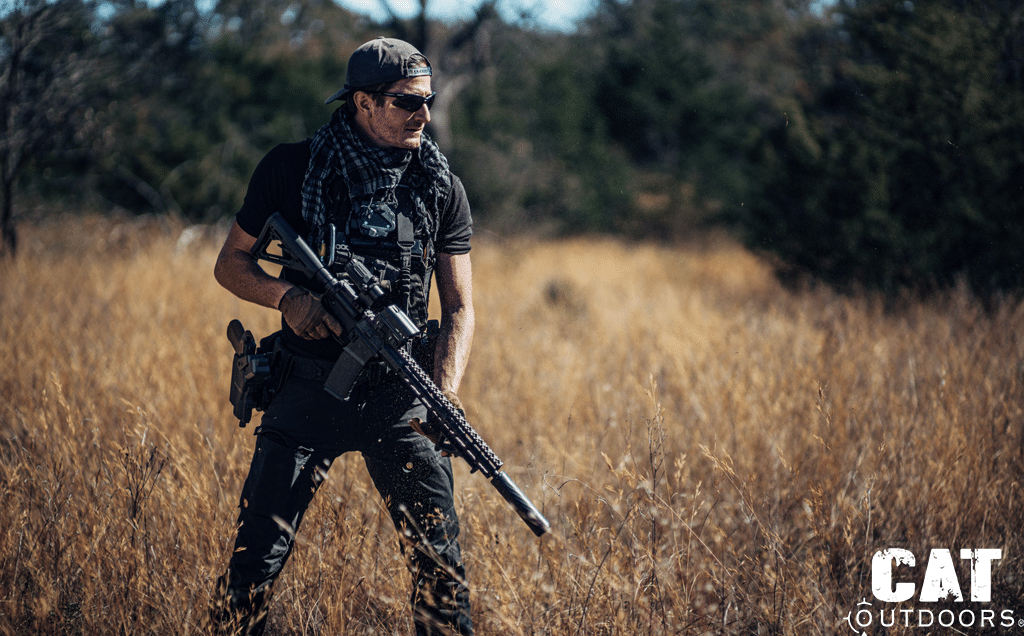
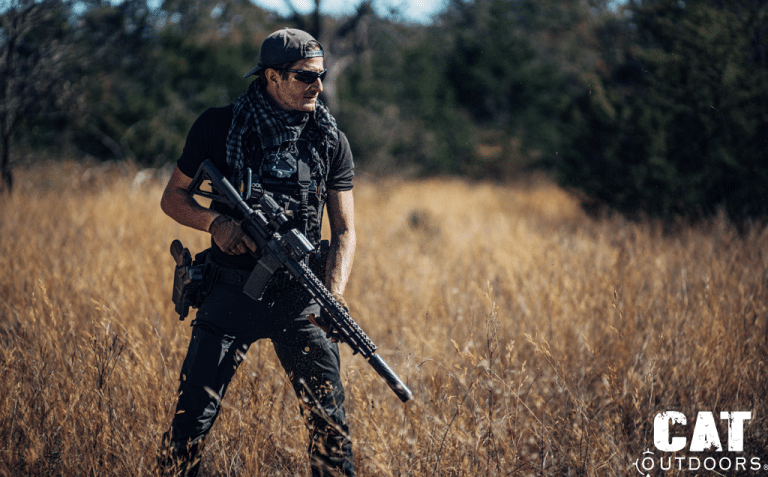
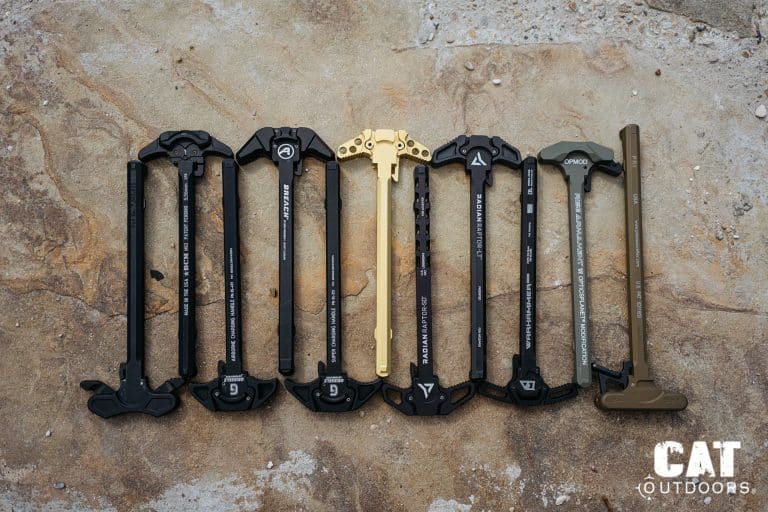
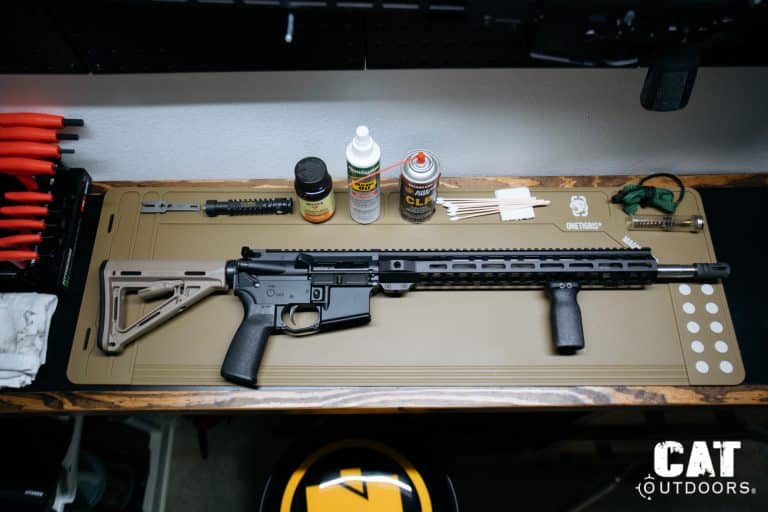



Spike machine makes AWESOME picatinny rail mount QD bayonets for modern AR’s, in lengths up to 12″.
I have reviewed them on my youtube channel.
m9 is the worst bayonet out there. I had over 200 in my arms room and they constantly broke. Better off with a $50 m7 AMZ clone. The wire cutter is f-ing stupid.